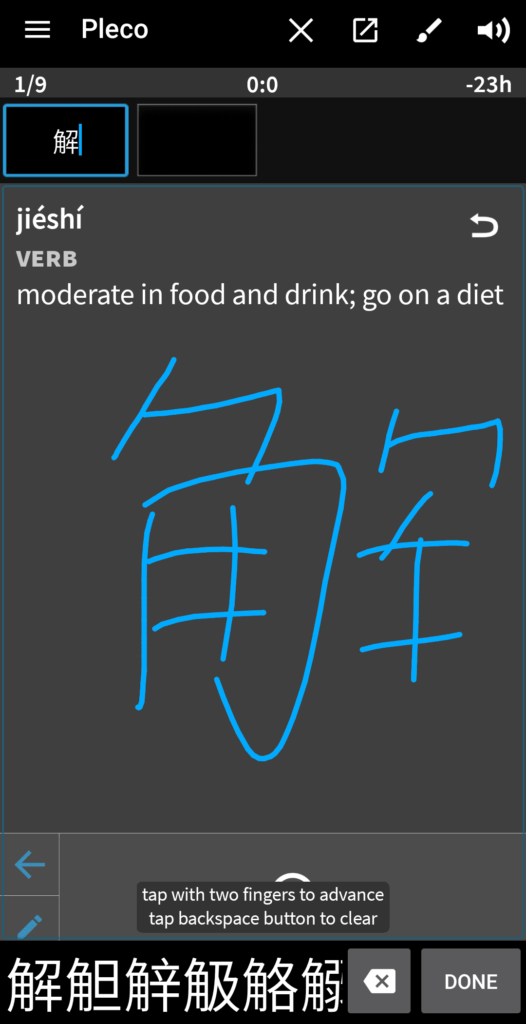Skritter Review — How I Learned 2,500 Chinese Characters
This is my full Skritter review — how I became addicted to the best app for learning Chinese characters.
In 2011, I became a raving fan of Skritter, an app used to teach you how to memorise Chinese characters (known as hanzi, or 汉字 in Simplified Chinese).
In those dark times, most people didn’t have tablets. Cell phones were a thing, but apps weren’t what they are today. So I used Skritter using an external tablet and digital pen from the same company responsible for many of the touchscreen interfaces of today.
And it worked. After using Skritter religiously for a year alongside my nearly daily Chinese lessons and practise
- I knew over 2,500 characters and many more words (words are compounds of multiple Chinese characters)
- I could easily differentiate between Chinese characters that looked similar
- I could read Chinese much faster than ever before
- My teachers would say my handwriting is very “neat”
So all of that was a success.

The following is a quick Skritter review showing what it looks like in 2020. It has come a long way!
If you buy Skritter through the links in this website you’ll support our work — we get a small commission with each purchase.
Contents
Skritter Review — Overview
Skritter is an app and website designed to help you learn Chinese characters.
It works equally well for Simplified Chinese and Traditional Chinese characters. It even works for Japanese characters (though I know less about that).
“But wait,” you cry in dismay. “Don’t you hate language-learning apps? Didn’t you cast them all into a fiery abyss in this article, screaming obscenities at them and anyone who dared to post their streak count on Reddit?”
No, we don’t hate apps. We use apps ourselves, even! We just warn against using them obsessively or relying on an app to get you to fluency by itself. No app will get you there. Mastering an app will mostly just help you master that app.
One of the hardest things to learn about Chinese (still definitely one of the hardest languages to learn for English speakers) is the fact that you have to learn so many characters. There are thousands, and you have to learn them even just to count.
The unfortunate realisation that everyone has about learning Hanzi (or Kanji, or Hanja if you’re a Korean obsessive) is that there’s no way to learn them all other than through memorisation.
And Skritter is an excellent way to memorise Chinese or Japanese characters.
What I like about Skritter
The first question anybody asks before investing heavily into an app is: does it work?
So: Does Skritter Work? Do you actually learn the characters?
The short answer is “Yes”. You do learn characters if you use Skritter.
That’s my Skritter review in a nutshell: you can indeed learn characters with it.
When I used Skritter, I learned over 2,500 characters with instant recall. It took many months of very hard work to get to this point so it wasn’t an overnight job. But I learned.
What I liked about Skritter included:
- Skritter forces you to trace out the characters. This comes pretty close to writing them without having to go through reams of paper.
- Skritter teaches stroke order. Stroke order is super useful — it helps your handwriting be natural. It also helped me with learning Korean, years later, since the Hangeul writing system uses the same stroke order rules.
- Skritter has lots of pre-built lists, including HSK lists. Even though eventually you should use your own lists, it’s super convenient that the most common characters are already pre-built. This was the case ten years ago and I can’t even imagine how many pre-built lists are in there. I did a check and there are lists from most textbooks I know.
- Skritter helps with pronunciation. It shows you the pinyin and even has audio.
Most of all, one of the most fun things about an app (like Skritter) is that they give you a structure.
With an app, you log in every day, do your homework, and tick the boxes. Even though this can produce an unproductivity trap, it’s nonetheless a great way to structure your learning (in moderation).
So whether I’m learning characters from my own studies or those from one of the HSK courses, I liked how Skritter gave me a concrete thing to do every day to take me closer to knowing enough characters.
What I don’t like about Skritter
That said, Skritter isn’t perfect (what is?), and so this Skritter review must contain some negative points.
The first thing to realise is that no spaced repetition program can totally reflect reality.
Spaced repetition systems (like Anki) are predicated on the fact that on average, we take a certain amount of time to forget a word (or character).
The thing is, we forget different words at different rates. Things that influence how often we forget words include
- The density of the “neural web” around a word — we form connections between one word and many other words. For example I know the character 电 (diàn, electricity) from 电话 (“electric speech”, a phone call), 电视 (“electric vision”, television), and 电脑 (“electric brain”, computer). All those help me remember the single character.
- How often we hear a word — I thought of that example because I see the character all the time in real life. Even if I don’t see the character, I see the objects whose names have the character, and these jog my memory.
- Whether something’s memorable for a random reason — like a funny-sounding word. Many foreigners learn and over-use the phrase 马马虎虎 (“horse horse tiger tiger”, which means “so-so”) just because it is so funny.
That’s just a non-academic analysis. There are other factors too, especially in non-Asian languages for European language learners. Like when I’m learning a word in Spanish or French, it helps me immensely if it’s related to any other words in English or another European language. (Sadly this happens a lot less in Asian languages — unless you know more than one.)
So if Skritter tries to teach me a character like 点, it’s going to try to teach it to me at the same pace it teaches me a far less common character. That’s artificial and places the same emphasis on two things that should have very different emphasis.
I should note that this is a weakness of all spaced repetition programs. It just means that the best way to learn is through contextual absorption. The more often we read things and the more often we say or write them, the more quickly we’ll learn them. Working this way, we’ll learn to understand, read, and write the things we most often use.

Free Alternatives to Skritter
Even though this is a Skritter review, I like to present free or alternative options.
If you’re on a budget — and who isn’t to some degree — you don’t have to buy Skritter. There are definitely ways of learning Chinese characters for free.
Learn Chinese Characters with Pleco
Pleco is the best Chinese dictionary out there. It’s one of the best Chinese language tools you can get.

Pleco has a flashcard tool inside it that you can use to learn characters. If you combine the flashcard tool with either the Pleco character recognition engine or with just your own phone’s ability to recognise characters, you have a pretty handy way of learning characters within the app.
I don’t really like the flashcard tool inside Pleco. It’s just a usability thing… it’s clunky. It provides so many options and through a confusing interface that leaves me wondering constantly if I’m using it in the most optimised way.
So Pleco isn’t a flashcard-first thing. It’s OK that Pleco isn’t amazing at everything because it’s already amazing at so much.
Also, Pleco isn’t truly free. The good dictionaries cost you money. But if you’re buying them anyway (and you should), then you can try the flashcard system, too.
Learn Chinese Characters with Anki
A second alternative to learning Chinese characters to Pleco is to use Anki.
Anki is the oldest and the original flashcard app. In fact, the predecessor to Anki was written by the person who made popular spaced-repetition learning in the modern age. Anki is very popular with language learners and med students.
You can use Anki to learn Chinese characters by using the feature all Android and iOS phones have that let you draw a character.
If you use that and “fill-in-the-blank” style cards in Anki, you have a great flashcard app with world-class spaced-repetition algorithms!
The reason people hesitate before taking up Anki is that the user interface is really complicated. Hey, it’s freeware! But still, there’s a lot to learn…
For example, to learn characters with Anki I’d suggest doing the following:
- Spend 30-60 minutes figuring out the nooks and crannies of the Anki app interface (use the desktop app, which is free)
- Create a note for your flashcards, which should include four fields (English, characters, pinyin, audio)
- Create two or three card layouts for your note, so you can learn the character from the meaning and the meaning from the character, and the pronunciation from the meaning/character
- Experiment with learning the characters in various different ways (meaning first, sound first, pinyin first…)
Basically Anki suffers from the same symptoms as Pleco — it has so many features that you wonder if you’re using it the right way.
It’s a terrible feeling to study a language for a while and learn a year after you start that you could have been doing it better!
Learn Chinese characters with — Paper and pen!
It’s worth mentioning paper and pen for two main reasons.
Firstly, it’s free and you already have all the apps downloaded and configured!
Secondly, though, you will learn to write.
Finger strokes on a screen don’t translate 1:1 to muscle memory of a hand writing on paper.
I still use the old pen-and-paper method for learning characters. If there’s a weird one, I write it out around ten times to try to drill it in. I might even write out some characters that look like it but aren’t quite it.






